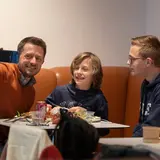From Concept to Strategy: Global Network Week at INCAE Business School
MAM students Tolulope Aigbiniode ’25 and Biamah Ampofo-Tenkorang ’25 traveled to Costa Rica as part of a program that sends Yale SOM students on weeklong exchanges to business schools around the world.

As business students passionate about impact and innovation, we were excited to spend Global Network Week (GNW) at INCAE Business School in Costa Rica, immersed in the theme “Sustainable Development: Moving from Concept to Strategy.” From the first day, it was clear that this would be more than an academic exercise. The trip was an opportunity to see firsthand how businesses in Latin America are embedding sustainability into core strategy.
INCAE’s campus sits in one of the most biodiverse regions in the world, which made for the perfect backdrop as we explored what it truly means to balance economic growth, social equity, and environmental responsibility. We kicked off the week with lectures led by researchers from the Latin American Center for Competitiveness and Sustainable Development (CLACDS), a think tank housed at INCAE. They challenged us to redefine progress as not simply GDP growth, but a holistic metric of well-being for people and the planet.
One highlight of the week was a simulation during which we “led” virtual countries over a 30-year period, making decisions about how to allocate resources and drive development. We had to invest in infrastructure, education, healthcare, environmental protection, and economic growth, and then observe how our decisions impacted both GDP and the Social Progress Index (SPI). The simulation was a powerful eye-opener. While GDP often rose with industrial investment, SPI scores didn’t always follow. In some cases, short-term GDP gains led to worsening environmental or social conditions. This revealed the limitations of GDP as a stand-alone metric and affirmed the SPI’s value as a broader, human-centered framework for measuring a country’s success.
We also explored sustainability impact assessments, learning how governments and businesses alike can evaluate proposed initiatives across environmental, social, and economic dimensions. These frameworks gave us a roadmap for embedding sustainability into real decision-making by identifying potential risks, forecasting outcomes, and deciding how to monitor and evaluate results over time.
Midweek, we shifted to examining how businesses can partner with underserved communities to build inclusive, scalable models. Through a case study focused on Warmi, a company that blends traditional Andean textiles with contemporary fashion to empower indigenous women artisans, we explored the intersection of cultural heritage, social impact, and sustainable business. We also explored five types of capital—economic, knowledge, leadership, network, and innovation—and how each plays a role in unlocking opportunity at the community level. The conversations pushed us to rethink traditional notions of business and development, highlighting that low-income populations are not just beneficiaries—they are co-creators and changemakers.


Beyond the classroom, we had the opportunity to visit three Costa Rican companies leading the way in sustainable innovation. At Data Center CR, a hydroelectric farm, we learned how the company pivoted from energy production to tourism and Bitcoin mining during the COVID-19 pandemic, creatively repurposing its infrastructure for different needs. It was a lesson in adaptive strategy and using excess capacity to drive entirely new business models.
At Finca La Hilda, a coffee farm, we learned about regenerative agriculture, from building terraces to prevent soil erosion to converting tree waste into biochar to enrich soil. It was inspiring to see traditional farming methods blend with sustainability innovations to create a circular ecosystem.
And at Florex, a sustainable cleaning products company, we explored the principles of the circular economy, from sourcing to packaging. The company’s approach showed how even small operational changes can lead to large environmental benefits when guided by purpose.
Our evenings and downtime were filled with cultural exploration. We climbed 500 steps to the La Fortuna waterfall, relaxed in geothermal hot springs, toured the rainforest in search of sloths and monkeys, and spent a few days on the beaches of Jaco. These experiences gave us a deep appreciation for Costa Rica’s natural beauty and a renewed commitment to protecting such ecosystems as future leaders.
More than just a week abroad, GNW at INCAE was a profound learning experience that connected sustainability concepts to strategic action. It challenged us to think critically, lead inclusively, and measure success more meaningfully.
For both of us, especially as Africans, it was inspiring to see the shared challenges and innovations between Latin America and Africa. Both regions face similar obstacles, yet are driving impactful solutions through creativity and resilience. This week opened our eyes to the great potential for collaboration, where shared strategies could lead to more innovative approaches to sustainability and business development.
Finally, the trip reinforced the idea that sustainable development isn’t a “nice to have” perk; it’s a strategic imperative. We left Costa Rica reminded that creating a better future happens not just in boardrooms or government offices, but in every decision we make.



